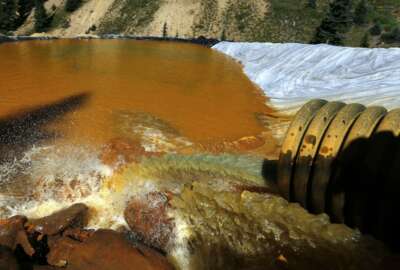
The EPA deploys an online way to track a troublesome chemical
Maybe you've heard of polyfluoroalkyl substances: PFAS. They have been used across industry. Their long life means they can build up in water supplies and possibly...
Maybe you’ve heard of polyfluoroalkyl substances: PFAS. They have been used across industry. Their long life means they can build up in water supplies and possibly harm human health. Now the Environmental Protection Agency has launched a website called PFAS Analytic Tools. It brings together many data sources about PFAS. To learn more about the site’s design and goals, the Federal Drive with Tom Temin spoke with program analyst Nicholas Spalt and chief of the Integration Targeting and Access Branch, Michael Barrette.
Interview transcript:
Tom Temin
Tell us about this site. What is it? What is it supposed to do? Who do you expect to take advantage of it?Michael Barrette
What we’ve created with the [Polyfluoroalkyl Substances (PFAS)] analytic tools is an automated integration portal that provides maps charts and tables about where PFAS is being reported, sampled or detected in the U.S. It lets users see where the chemicals are made, whose reported releasing them into the environment, and where they may be used in industry. It also lets you see where PFAS has been identified within the federal government framework like military bases. The information is scattered around in 11 different databases. So what we wanted to do here is develop a holistic view that can let users zoom into their local community and see what information is available. And we know researchers and journalists are using it now to study things like fish contamination, and connections between environmental detections of PFAS and what their sources may be. So if you wanted to check your local area to find out results of let’s say, drinking water samples, or water discharges, and toxic releases. You can just zoom into the map and dive into the information.Tom Temin
Now, is all of the information there recorded by [Environmental Protection Agency] research? Or is this local reporting saved by state and local agencies or other regulated entities out there that also have to report what they’re doing for PFAS? Give us a sense of the range of data in there.Michael Barrette
Yeah, it’s a combination of different things. Some are coming from the states, some are coming from companies that are actually manufacturing the tools. Some may be from research done by either EPA or the states. And you might see information like fish tissue sampling, and how much PFAS is in those fish, or who’s making the chemicals? How long have they made them? Where are they making them? How much have they made? Or things like, what are the toxic releases that have been put into the water?Tom Temin
Got it. Just a quick background question on these chemicals. They are made to be used in subsequent manufacturing. So is the danger from the manufacturing of the raw chemicals, the PFAS types of chemicals? Or if you make a bottle, or something out of it, does that thing that it’s made from also become a possible source of pollution?Michael Barrette
So there are multiple pathways where PFAS can get into the environment. And so obviously, where the chemicals are made are a concern that we would want to look at. But then there are downstream uses. And there are many uses. And people in their homes may have heard that you have this in, let’s say a nonstick pan, or any type of clothing that has waterproofing on it, or maybe cosmetic products. Those are the type of things it’s used for. There may be many other uses that are out there. And so as EPA, and states are getting a handle on how PFAS is getting into the environment. You have to study all those different things. You have to study things like firefighting foam, and where that’s been sprayed. So there’s a lot of different potential ways that this can get into the environment.Tom Temin
Got it. And is the website as it stands now complete? Or are there other sections type sources of data, that you would like to have that maybe don’t exist yet or aren’t coming in to the EPA?Michael Barrette
Well, we made a conscious decision to put the information out in the form that it is now, so that the public could have access to it. That said, many of the databases are still filling in. So in some circumstances, we don’t have information from all states. But we are continuing to look for other data. And we’re going to just keep growing the tool out adding it. Some of the things that we may like to see in the future, would be information on biosolids or pretreatment or air releases. Those are places that we’re right now we don’t have a lot of information.Tom Temin
And what is the status, Nicholas, of PFAS now? That is to say it’s a regulated chemical. Has it been banned yet? I know that some fire departments are no longer using that. The military is trying to get away from PFAS based foam, at bases and so forth. Where does it stand in kind of a cycle of EPA and regulation, and that whole cycle?Nicholas Spalt
Where we are standing now is kind of like in a research aspect, related to PFAS. So an EPA strategic roadmap, we do have a viewpoint of looking at these chemicals, exposures and toxicities related to PFAS. So, as Mike said earlier, there’s over 12,000 chemicals that are currently considered as PFAS. And we’re still working to understand the entire class of PFAS. And we’re also working to restrict PFAS introduction into the environment and remediate it, where it has been introduced to the environment, and there are exposures to people. So that’s kind of where we’re standing right now.Tom Temin
And at the top, I mentioned anyhow, that is long lasting. It this one of those things that lasts forever and ever? Even after, say a factory closes or changes its practices and so forth. Could there be like a love canal type of thing somewhere in the future, because of the longevity?Michael Barrette
I think that there have been, obviously, media reports about some areas where there have been manufacturing where there’s serious concern. But as we go forward, that’s part of the reason we launched this tool. Was to try to understand where the highest detections are coming up. And I would say that, although this is considered an emerging pollutant, it has been around for a bit of time. EPA is trying to kind of tighten the regulatory structure. We’re working right now, to essentially create a hazardous substance designation under Superfund that would tighten in on the regulations on that aspect. We also have developed a final rule that is going to require nationwide sampling of 29 PFAS chemicals in drinking water. And we’re also proposing additional rules, to make sure that certain PFAS can’t reenter the marketplace, if the use has been discontinued. And we’re also looking right now taking a final action to better characterize the quantities and sources of PFAS manufactured in the U.S. So as we go forward, we’re seeing the regulatory aspect tighten up. And that’s going to also be providing more data that people can kind of see within this tool.Tom Temin
Got it. And with respect to the tool itself, what is the uptake been? Are you getting metrics for who’s visiting, how long they were there, the types of data that they’re looking at when they are there?Michael Barrette
We’re starting to look at that. We did a national webinar, we’ve had over 1,000 folks on that. We’ve seen the usage start to spike up listed people, academia, private industry, other government agencies. When, let’s say a wastewater or drinking water plant starts to see PFAS pop up, they can use our tool to try to figure out who’s nearby that could be causing it. And we think that’s one of the most important use cases for this tool.Tom Temin
Sure. And are there particular, like geographical areas of the country where this is more prevalent? And maybe there’s some way of letting people know, hey, you can look it up?Michael Barrette
Yeah, I think generally, the research is showing that because these chemicals are all across the country that the literature showing that, people have small amounts of PFAS in their blood. But if you’re near a source that has been providing, let’s say a dose of the PFAS chemicals over a long period of time. Then that’s of higher concern. And that’s where we want to look. We know that the manufacturing aspect is mostly east of the Mississippi River. However, if you think about firefighting foam, you have airports, you have military bases, those are kind of scattered across the U.S. So that’s what hopefully this tool can help people start researching in more detail.Tom Temin
And there has been other recent legislation on infrastructure, as everyone knows, at this point. And a lot of that is directed toward local and state water supply operators. That’s where water originates at the municipal and local level, county level. I imagine this would be useful to those authorities and operators, just to save time, they don’t have to keep calling the EPA. Whereas PFAS, if we’re updating our water supply, we can look it up ourselves. Is that part of the goal here?Michael Barrette
Definitely true. But it’s also a two way street that we would love to receive more information. And particularly in states that may not have published this yet. If a member of the public is actually looking at the tool and they see not a lot of information in it, then I would definitely urge them to also look on state and local websites. Because it’s possible that there’s data out there that we haven’t been able to take in yet.Tom Temin
And Mr. Spalt, anything to add?Nicholas Spalt
Just so far we’ve been working closely with state agencies and local authorities and using the tool. So helping them developing sampling plans would be a perfect use case of using the PFAS analytic tools.Tom Temin
And a lot of manufacturers, I guess have given up voluntarily using it. People that make, I think there was a brouhaha over water bottles, permanent types of containers. People use reusable that industry has kind of gotten away from these.Michael Barrette
We have had some companies that have joined, kind of voluntary phase outs, over the years. But again, that’s something that a lot of these chemicals are super useful in products. And so they’re looking for alternatives. And we’re hoping, as we set these regulatory structures up that those are much safer than what they used in the past.
Copyright © 2025 Federal News Network. All rights reserved. This website is not intended for users located within the European Economic Area.
Tom Temin is host of the Federal Drive and has been providing insight on federal technology and management issues for more than 30 years.
Follow @tteminWFED





